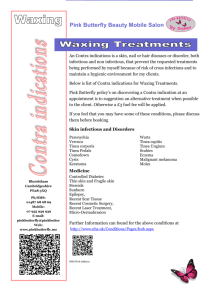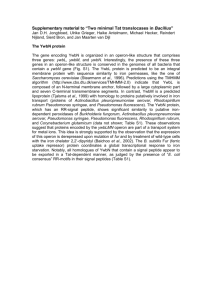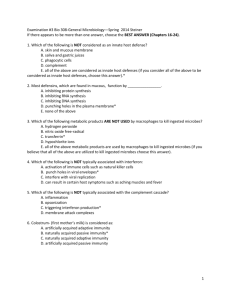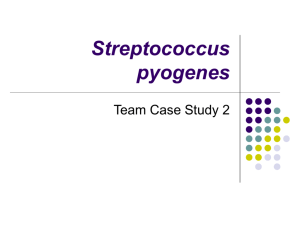Microbiology / Active Lecture Questions Chapter 21 / Microbial
advertisement
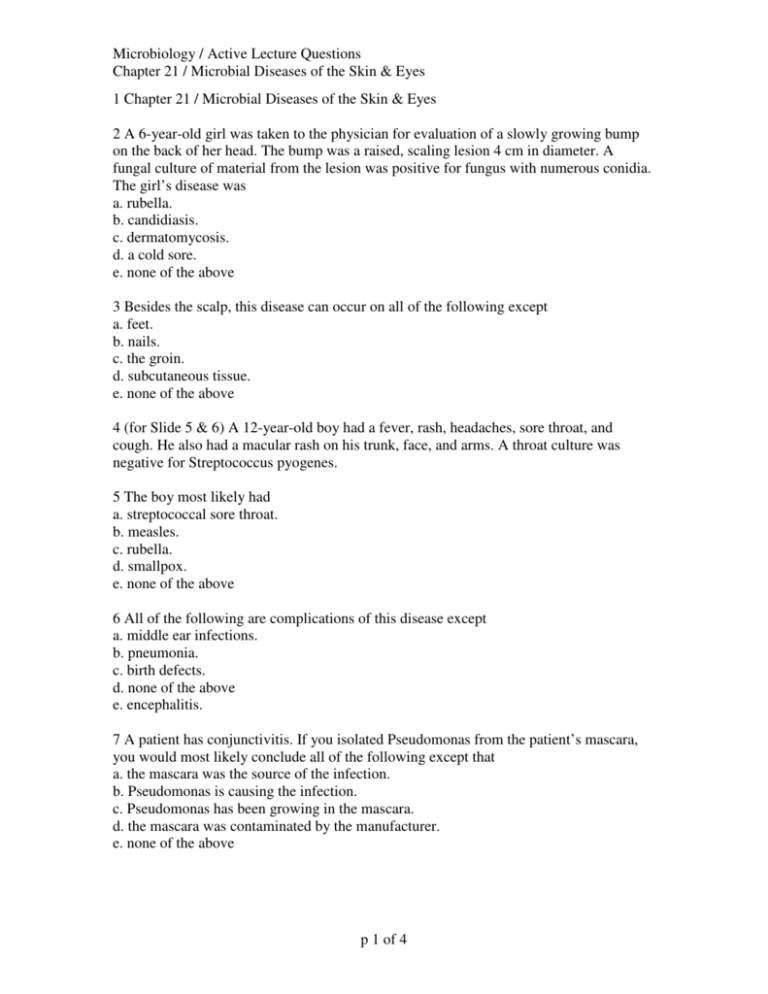
Microbiology / Active Lecture Questions Chapter 21 / Microbial Diseases of the Skin & Eyes 1 Chapter 21 / Microbial Diseases of the Skin & Eyes 2 A 6-year-old girl was taken to the physician for evaluation of a slowly growing bump on the back of her head. The bump was a raised, scaling lesion 4 cm in diameter. A fungal culture of material from the lesion was positive for fungus with numerous conidia. The girl’s disease was a. rubella. b. candidiasis. c. dermatomycosis. d. a cold sore. e. none of the above 3 Besides the scalp, this disease can occur on all of the following except a. feet. b. nails. c. the groin. d. subcutaneous tissue. e. none of the above 4 (for Slide 5 & 6) A 12-year-old boy had a fever, rash, headaches, sore throat, and cough. He also had a macular rash on his trunk, face, and arms. A throat culture was negative for Streptococcus pyogenes. 5 The boy most likely had a. streptococcal sore throat. b. measles. c. rubella. d. smallpox. e. none of the above 6 All of the following are complications of this disease except a. middle ear infections. b. pneumonia. c. birth defects. d. none of the above e. encephalitis. 7 A patient has conjunctivitis. If you isolated Pseudomonas from the patient’s mascara, you would most likely conclude all of the following except that a. the mascara was the source of the infection. b. Pseudomonas is causing the infection. c. Pseudomonas has been growing in the mascara. d. the mascara was contaminated by the manufacturer. e. none of the above p 1 of 4 Microbiology / Active Lecture Questions Chapter 21 / Microbial Diseases of the Skin & Eyes 8 You microscopically examine scrapings from a case of Acanthamoeba keratitis. You expect to see a. nothing. b. viruses. c. gram-positive cocci. d. eukaryotic cells. e. gram-negative cocci. 9 Nothing is seen in a microscopic examination of a scraping from the patient’s rash. a. Pseudomonas b. S. aureus c. scabies d. Sporothrix e. virus 10 Microscopic examination of the patient’s ulcer reveals ovoid cells. a. Pseudomonas b. S. aureus c. scabies d. Sporothrix e. virus 11 Microscopic examination of scrapings from the patient’s rash shows gram-negative rods. a. Pseudomonas b. S. aureus c. scabies d. Sporothrix e. virus 12 Which of the following pairs is mismatched? a. leading cause of blindness—Chlamydia b. chickenpox—shingles c. HSV-1—encephalitis d. Buruli ulcer—stomach acid e. none of the above 13 The waterproofing protein in the skin is called a. Sebum b. Keratin c. Melanin d. Lysozyme 14 Which of these organisms is a diphtheroid and inhabits hair follicles? a. Propionibacterium acnes b. Malassezia furfur p 2 of 4 Microbiology / Active Lecture Questions Chapter 21 / Microbial Diseases of the Skin & Eyes c. Streptococcus pyogenes d. Staphylococcus aureus 15 Shampoos for treating dandruff contain an antibiotic and chemicals to treat a a. Fungus b. Bacterium c. Virus d. Protozoa 16 Which organism produces a toxin that causes scalded skin syndrome? a. Streptococcus b. Pseudomonas aeruginosa c. Staphylococcus d. Mycobacterium ulcerans 17 Which one of the following dissolves blood clots? a. Streptokinase b. Streptolysin c. Hyaluronidase d. Deoxyribonuclease 18 Necrotizing fasciitis is caused by Streptococcus pyogenes and is transmitted by a. Direct contact b. Indirect contact c. Contaminated water d. Contaminated food 19 Warts are caused by a. Sporothrix schenckii b. Papillomaviruses c. Microsporum d. Trichophyton 20 Which of the following is an occasional severe complication of a viral disease? a. Reye Syndrome b. Toxic Shock syndrome c. Scalded skin syndrome d. Tinea pedis 21 Which of the following is responsible for severe birth defects if contracted during pregnancy? a. Measles virus b. Rubella c. Varicella-zoster virus d. Human parvovirus B19 p 3 of 4 Microbiology / Active Lecture Questions Chapter 21 / Microbial Diseases of the Skin & Eyes 22 Which of the following causes ringworm? a. Microsporum b. Sarcoptes scabiei c. Papillomavirus d. Sporothrix schenckii 23 Athlete’s foot is caused by a. Tinea capitis b. Tinea cruris c. Tinea pedis d. Tinea unguium 24 Which disease is usually diagnosed by microscopic examination of skin scrapings and is usually treated with permethrin? a. Scabies b. Pediculosis c. Candidiasis d. Sporotrichosis 25 Using a homemade saline solution for contact lenses can result in a. Acanthamoeba keratitis b. Trachoma c. Ophthalmia neonatorum d. Inclusion conjunctivitis 26 Which organism can be treated with silver nitrate, tetracycline, or erythromycin? a. Neisseria gonorrhoeae b. Adenovirus c. Herpes simplex type 1 virus d. Haemophilus influenzae 27 What is the most common bacterial cause of conjunctivitis? a. Neisseria gonorrhoeae b. Chlamydia trachomatis c. Haemophilus influenzae d. Streptococcus pyogenes p 4 of 4

